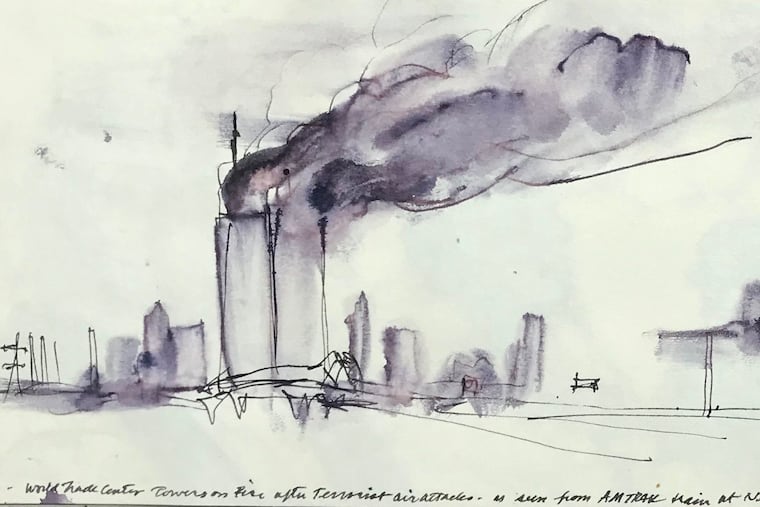‘The towers were burning’: The view of 9/11 as a train from Philly pulled into New York | Opinion
Acclaimed landscape architect Laurie D. Olin was on his way to New York as the first plane hit.

On the morning of Sept. 11, 2001, I took a train to New York from 30th Street Station. It was a glorious fall day with a deep-blue sky and colorful autumn foliage reflected in the Schuylkill as we crossed it.
About the time we were pulling into Trenton, cellphones started going off all over the car, and people were looking around. The train left Trenton and went on across New Jersey, but long before we reached New Brunswick people were talking about a plane hitting one of the World Trade Center towers. I remembered that in the 1940s a plane had crashed into the Empire State Building, and thought about what a bad accident this must be. Then people began talking about a second plane and we all were looking out the window as the train passed the flat floodplain west of Staten Island between Newark airport and the cargo terminals.
And then we could see the Lower Manhattan skyline. The towers were burning.
We pulled into Newark. People got off; people got on, and the train departed for Manhattan. I did what I often do when trying to understand and process the world before me. I took out a sketchbook and drew until the train went into the tunnel.
I was going to New York that day because it was to be the second day of a marathon three days of presentations that Frank Gehry, Alex Cooper, and I were making to all the constituencies at Lincoln Center for our new master plan for the ensemble — its buildings, public spaces, and services. I’d arranged to stay overnight with a friend in the Village so that I wouldn’t have to take the train three days in a row.
The train pulled into Penn Station and we all got off. The place was pandemonium.
I decided to go on uptown to the Lincoln Center to find the people who I knew who might have gone there earlier to see what had happened. I knew the meeting was off, and wasn’t sure if we were somehow suddenly at war with some country. One’s brain and logic do odd combinations in such crises — a mix of the thoroughly practical and nonsensical.
I started walking north and was thinking about the structure of the World Trade Center towers that Les Robertson, the engineer who’d worked with Minoru Yamasaki on it, had designed. I’d known him since the 1960s in Seattle. The towers basically had an exoskeleton of tubes on their perimeter, and the floors were attached to them. I was thinking that if a couple of floors were broken loose, they’d fall down, and if a couple of them fell onto a third or fourth, the accumulating weight would cause them all to cascade and collapse in sequence.
A few blocks north of the station, a group of people were standing around in a circle outside a bodega listening to a portable radio on the sidewalk. As we listened, the first tower came down. It was as terrible as I had imagined.
A few minutes later, strangely enough, I found a taxi and we drove up to Lincoln Center. About half the people were there. We listened to the radio for a while. There would be no meeting or presentation, of course.
After an hour or so, I walked back downtown with a few others from the meeting. We walked across a portion of Central Park to find Frank Gehry at the hotel where he and his wife, Berta, and two sons and a girlfriend were staying. There were streams of people walking north in the park and on all the streets — a quiet but steady evacuation of Lower Manhattan. There was almost no traffic. We found Frank and spent much of the day sitting around, talking, wondering. It is the only time I have ever seen Frank take a drink in the daytime.
Later I walked down Fifth Avenue, at times in the middle of the street, to my friend’s place on Eighth Street. It was strange walking downtown toward the smoke. There was only smoke where the silhouette of the towers had been for decades. The only vehicles on the street were occasional large construction pieces and heavy equipment headed south, and there was a constant sound of distant sirens.
Another friend of my host, who was stranded on his way to Israel because all the airports were closed, came over. There wasn’t much in the house for dinner, so we wandered out to see what we could find. The streets were empty, but a neighborhood Italian restaurant was strangely open and crowded. Yes, they could seat us. They’d serve until they ran out of clean dishes. The power was off and there were candles on the table and in the kitchen, with cooking by gas. The place was packed. Every seat was filled. The food was delicious, and everyone was totally silent.
None of us knew what to say to each other.
Laurie D. Olin is practice professor emeritus of landscape architecture at the University of Pennsylvania, where he has taught for 40 years, and former chair of the department of landscape architecture at Harvard University. Olin was the landscape architect for the Barnes Foundation. His redesign of the Washington Monument grounds received the 2008 Design Honor Award from the American Society of Landscape Architects.